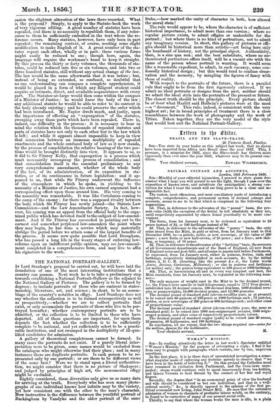THE NATIONAL PORTRAIT-GALLERY.
Ix Lord Stanhope's proposal be carried out, he will have laid the foundation of one of the most interesting institutions that a -country can possess. Next week he is to take a preliminary step towards establishing a National Portrait-Gallery as the adjunct to the National Gallery of Pictures. The gallery is to be formed by degrees ; to include portraits of those who are eminent in states- Utanship, literature, art, and science ; in short, to be an assem- blage of the country's notables in effigy. Lord Stanhope does not say whether the collection is to be formed retrospectively as well as prospectively,—whether we are to collect portraits that exist, or only accumulate the portraits of those who live to be por- trayed hereafter ; whether contemporary portraits are to be admitted, or the collection is to be limited to those who have departed. All of these questions are important, for upon them depends the fact whether the collection is to be sufficiently oomplete to be national, and yet sufficiently select to be a practi- cable institution, and not swamped in the multiplicity of ill-qua- lified candidates for admission.
A gallery of theoretical completeness cannot be formed. In many eases the portraits do not exist. If a purely literal inter- pretation were to be given some names would be excluded from the catalogue who might Otherwise find their place ; and. in many instances there are duplicate portraits. Is each person to be re- presented only by one portrait ; or are -there to be different views of the same face.? Were we to stand upon a literatauthentica- lion we might consider that there is no picture of Shakspere ; and judged by principles of high art, the monumental effigy might be excluded. Rightly considered, these diversities only give us so many data for arriving at the -truth. Everybody who has seen many photo- graphs of one individual knows how infinite may be the variety, yt how consistent one with the other to the man's character. flow instructive is the difference between the youthful portrait of Buckingham by Vandyke and the older portrait of the same
Duke,—how marked the unity of character in both, how altered the moral state !
The rule would appear to be, where the character is of sufficient historical importance to admit more than one version ; where no regular picture exists, to admit effigies or makeshifts for the portrait ; but where there is no kind of portraiture, not to admit any imaginary version. In short, this gallery of pictures or effi- gies should be historical more than artistic—art being here only the handmaid of _history, not the principal object. Authenticity, then, is a sine qua non ; and the best substitute, where no au- thenticated portraiture offers itself, will be a vacant site with the name of the person whose portrait is wanting. It would seem like a reasonable expedient, to admit, in such vacancy, some con- fessedly historical design ; but this would tend to confuse obser- vation and the memory, by mingling the figures of fancy with those of reality.
With respect to the portraits of the future, there is a parallel rule that ought to be from the first rigorously enforced. If we admit no ideal portraits or designs from the past, neither should we admit the ideal style into the portraits of the present or future. The closest truth should be the principle. Every picture should be at least what Hazlitt said Holbein'spictures were at the most —a "document." This rule, indeed, is consistent with the very highest art; for in broad principles of treatment there is a dose resemblance between the work of photography and the work of Titian. Taken together, they are the very model of the style that would best suit the National Portrait-Gallery.


































 Previous page
Previous page